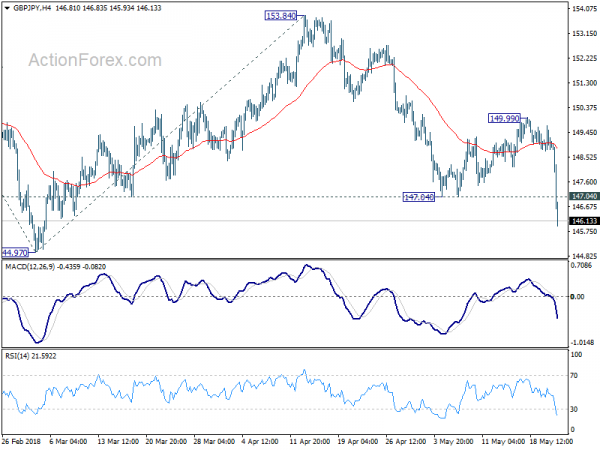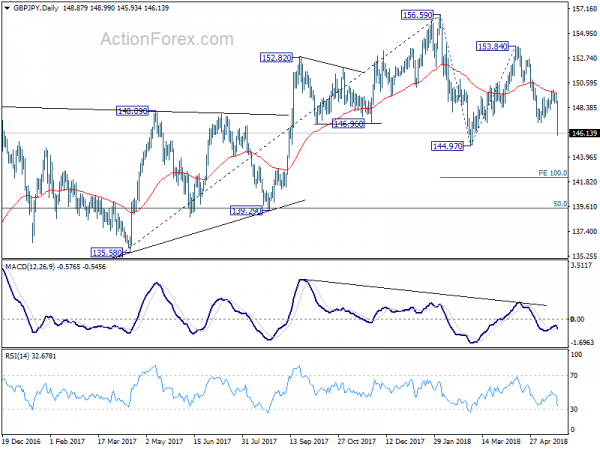Yen surges broadly today as driving by steep decline in major European and US treasury yields. German 10 year bund yield dropped to as low as 0.497, comparing to prior day’s close at 0.559, and it’s now at 0.500. UK 10 year gilt yield reached as low as 1.446, comparing to prior day’s close at 1.523, and it’s now at 1.448. US 10 year yield reaches as low as 3.003, comparing to prior day’s close at 3.063, and it’s now at 3.018. Major European indices are trading deeply in red with DAX down -1.70%, CAC down -1.40% and FTSE down -0.78% at the time of writing. DOW futures also point to triple digit loss at open.
Risk aversion is a major factor in driving the markets today. But central bank expectations after data miss is equally important. Markets got nervous after US President Donald Trump said he’s “not satisfied” with the trade talks with China. USD/JPY got some support today after Trump tweeted that the trade deal with China is “moving along nicely.” But the overall market confidence was already hurt by the confusing, ever-changing comments.
There are still a lot of uncertainties regarding Italy. Italian President Sergio Mattarella will meet with Prime Minister candidate, politic novice law professor Giuseppe Conte today. It’s uncertain whether Conte will get Mattarella’s appointment. 5-star and the League, though, are still insisting on having Conte as the Prime Minister. But even if this uncertainty is cleared, the new Eurosceptic government will almost certainly clash with EU down the road. Selloff in Italian 10 year bonds continue today with yield up 0.1 at the time of writing to 2.4.
Safe haven flows into major European bonds is of course a factor driving yield down. More so, is appointing data prompt investors to pare back their expectations. UK April CPI missed again and an August BoE rate hike is getting more distant. Eurozone PMIs also point to further slowdown in growth momentum which could delay ECB’s exit of asset purchase program.
Looking ahead, Fed will release FOMC meeting minutes. We’re not expecting anything drastic from the FOMC minuets. It won’t likely change the fully priced in June hike. And Fed in on course for another hike in September. Meanwhile, it’s too early to tell whether one more hike in December is needed.
Pound hammered by UK CPI miss, ONS blamed timing of Easter
Pound was knocked down after another data miss. Headline CPI slowed for the third month in a row to 2.4% yoy in April, down from 2.5% yoy and missed expectation of 2.5% yoy. Core CPI also slowed to 2.1% yoy, down from 2.3% yoy and missed expectation of 2.2.% yoy.
The Office of National Statistics noted that air fares made the largest downward contribution to the change in CPI. It noted that “the timing of Easter in the middle of April 2017 contributed to air fares rising by 18.6% on the month whereas this year, Easter fell at the beginning of April before the price collection period and there was no price rise. Instead, fares fell slightly, by 0.2%, between March and April.
Also from UK, RPI accelerated to 3.4% yoy in April, up from 3.3% yoy, met expectation. PPI input rose to 5.3% Yoy, PPI output was unchanged at 2.7% yoy, PPI output core slowed to 2.4% Yoy. House price index was unchanged at 4.2% yoy in March. CBI reported sales rose to 11 in May versus expectation of 4.
Eurozone PMI hit 18-month low, but still point to 0.4% GDP growth in Q2
Eurozone PMI manufacturing dropped to 55.5 in May, down from 56.2, missed expectation of 56.0, hitting 15-month low. PMI services dropped to 53.9, down from 54.7, missed expectation of 54.7, hitting, 16-month low. PMI composite dropped to 54.1, down from 55.1, hitting 18-month low.
Chris Williamson, Chief Business Economist at IHS Markit urged a “note of caution” interpreting the data. In particular, “despite the headline PMI dropping to an 18-month low, the survey remains at a level consistent with the eurozone economy growing at a reasonably solid rate of just over 0.4% in the second quarter.” Though, it’s becoming “increasingly evident that underlying growth momentum has slowed compared to late last year”. And the May’s results will “rekindle some concerns regarding downside risks facing the euro area economy.”
Also from Eurozone, Germany PMI manufacturing dropped to 56.8 in May, down from 58.1, missed expectation of 57.9. That’s the lowest in 15 months. PMI services dropped to 52.1, down from 53.0, missed expectation of 53.1. That’s a 20-month low. PMI composite dropped to 53.1, down from 54.6, hitting 20-month low.
France PMI manufacturing rose to 55.1 in May, up from 53.8 and beat expectation of 53.7, hitting 3 month high. But PMI services dropped to 54.3, down from 57.4 and missed expectation of 57.2, hitting 16- month low. PMI composite dropped to 54.5, down from 56.9, hitting a 16 month low.
ECB Coeure: Asset purchase will end this year
ECB Executive Board member Benoit Coeure he’s not worried about slowdown and the central bank is still on course to end the asset purchase program this year. Coeure told German newspaper Die Zeit that “at the end of last year, I said that I didn’t expect that our asset-purchase program would need to be extended again. I see no reason to change my view.” And, policymakers expect the economic expansion to continue, and are “increasingly confident that inflation will rise towards our aim of below, but close to, 2 percent.”
Regarding the upcoming new Italian government. Coeure said “it’s too early to comment on plans we don’t know.” But he emphasized that “on fiscal policy in general, the ECB’s view is well known: Europe has fiscal rules and they should be respected.”
RBNZ has significant room for easing, no need for unconventional policies
RBNZ released a 22-page bulletin article titled “Unconventional monetary policy since the Global Financial Crisis” today. In a summary, RBNZ hailed that the “unconventional” monetary policies adopted by some major central banks were “successful in easing financial conditions”. And, there were “emerging research suggests they boosted inflation and activity.”
But in case of RBNZ, the OCR is currently at 1.75%, and it’s “not projecting a significant decrease in the OCR”. Therefore, RBNZ has “significant further room to ease monetary policy in a conventional way, and conventional monetary policy remains effective in influencing inflation and activity.”
Separately, RBNZ Assistant Governor John McDermott said in an interview that while there is “no imminent prospect” of using unconventional policy, the probability of needing them at this point in the cycle is higher than it ever was in history”. Therefore, “it would be silly of us not to be ready just in case.”
Japan PMI: Weakest expansion in manufacturing growth in nine months
The Nikkei flash Japan manufacturing PMI dropped to 52.5 in May, down from 53.8 and missed expected of 54.6. In the release it’s noted that new order growth softened to 9-month low. However, input prices surged at the fastest pace since January 2014. Also, Joe Hayes, Economist at IHS Markit, noted that “headline figure signalled the weakest expansion in manufacturing growth in nine months.” Employment growth also eased. But, new export sales rose faster due to USD/JPY rise. Meanwhile, “input prices soared at the fastest pace in 52 months.”
Also from Japan, all industry activity index rose 0.0% mom in March, below expectation of 0.1% mom.
GBP/JPY Mid-Day Outlook
Daily Pivots: (S1) 148.57; (P) 149.15; (R1) 149.54; More…
GBP/JPY’s decline accelerates to as low as 145.94 so far after breaking 147.04. Fall from 153.84 has resumed and intraday bias remains on the downside for 144.97 low. Break there will resume the fall from 156.59 and target 100% projection of 156.59 to 144.97 from 153.84 at 142.22 next. On the upside, above 147.04 will turn intraday bias neutral and bring recovery. But upside should be limited well below 149.99 to bring fall resumption.
In the bigger picture, for now, we’re treating price actions from 156.59 as a corrective move. Therefore, while deeper fall is expected, strong support should be seen above 139.29 cluster support (50% retracement of 122.36 to 156.59 at 139.47) to contain downside and bring rebound. There is still prospect of extending the rise from 122.36. However, considering that GBP/JPY failed to sustain above 55 month EMA (now at 153.94), firm break of 139.29 will confirm trend reversal and turn outlook bearish.
Economic Indicators Update
| GMT | Ccy | Events | Actual | Forecast | Previous | Revised |
|---|---|---|---|---|---|---|
| 0:30 | JPY | PMI Manufacturing May P | 52.5 | 53.6 | 53.8 | |
| 0:30 | AUD | Westpac Leading Index M/M Apr | 0.20% | -0.20% | ||
| 1:30 | AUD | Construction Work Done Q1 | 0.20% | 1.30% | -19.40% | -18.30% |
| 4:30 | JPY | All Industry Activity Index M/M Mar | 0.00% | 0.10% | 0.40% | |
| 7:00 | EUR | France Manufacturing PMI May P | 55.1 | 53.7 | 53.8 | |
| 7:00 | EUR | France Services PMI May P | 54.3 | 57.2 | 57.4 | |
| 7:30 | EUR | Germany Manufacturing PMI May P | 56.8 | 57.9 | 58.1 | |
| 7:30 | EUR | Germany Services PMI May P | 52.1 | 53.1 | 53 | |
| 8:00 | EUR | Eurozone Manufacturing PMI May P | 55.5 | 56 | 56.2 | |
| 8:00 | EUR | Eurozone Services PMI May P | 53.9 | 54.7 | 54.7 | |
| 8:30 | GBP | CPI M/M Apr | 0.40% | 0.50% | 0.10% | |
| 8:30 | GBP | CPI Y/Y Apr | 2.40% | 2.50% | 2.50% | |
| 8:30 | GBP | Core CPI Y/Y Apr | 2.10% | 2.20% | 2.30% | |
| 8:30 | GBP | RPI M/M Apr | 0.50% | 0.50% | 0.10% | |
| 8:30 | GBP | RPI Y/Y Apr | 3.40% | 3.40% | 3.30% | |
| 8:30 | GBP | PPI Input M/M Apr | 0.40% | 1.00% | -0.10% | 0.10% |
| 8:30 | GBP | PPI Input Y/Y Apr | 5.30% | 5.80% | 4.20% | 4.40% |
| 8:30 | GBP | PPI Output M/M Apr | 0.30% | 0.30% | 0.20% | 0.30% |
| 8:30 | GBP | PPI Output Y/Y Apr | 2.70% | 2.30% | 2.40% | 2.70% |
| 8:30 | GBP | PPI Output Core M/M Apr | 0.10% | 0.30% | 0.10% | 0.20% |
| 8:30 | GBP | PPI Output Core Y/Y Apr | 2.40% | 2.10% | 2.20% | 2.70% |
| 8:30 | GBP | House Price Index Y/Y Mar | 4.20% | 4.40% | 4.40% | 4.20% |
| 10:00 | GBP | CBI Reported Sales May | 11 | 4 | -2 | |
| 13:45 | USD | Manufacturing PMI May P | 56.5 | 56.5 | ||
| 13:45 | USD | Services PMI May P | 54.8 | 54.6 | ||
| 14:00 | USD | New Home Sales Apr | 678K | 694K | ||
| 14:00 | EUR | Eurozone Consumer Confidence May A | 0.5 | 0.4 | ||
| 14:30 | USD | Crude Oil Inventories | -1.4M | |||
| 18:00 | USD | FOMC Meeting Minutes |













